BSBRSK501 Risk Management Assignment: Analysis and Implementation
VerifiedAdded on 2023/01/19
|18
|3228
|37
Homework Assignment
AI Summary
This assignment solution addresses the core concepts of risk management, encompassing operational, strategic, and external risk categories. It provides detailed responses to a series of questions, covering elements such as risk identification, analysis, evaluation, and treatment. The solution includes a comprehensive analysis of risk criteria, stakeholder identification, and the application of tools such as SWOT and PESTL analysis. Furthermore, the assignment details the development of a risk management plan, including an action plan, implementation strategy, and continuous review mechanisms. The context of the assignment is a case study involving a company expansion, requiring an analysis of external factors, stakeholder identification, and the creation of a risk assessment and management plan.
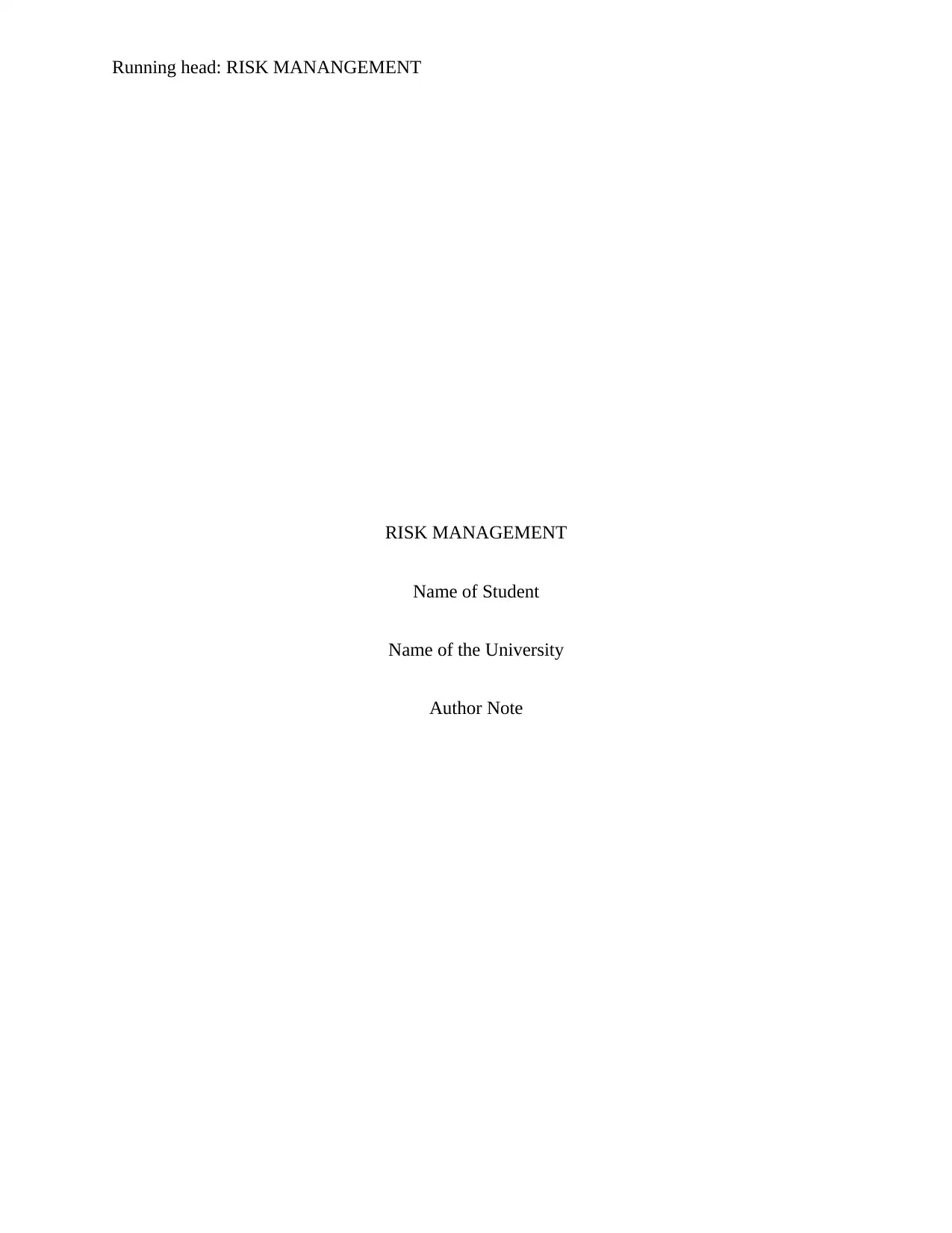
Running head: RISK MANANGEMENT
RISK MANAGEMENT
Name of Student
Name of the University
Author Note
RISK MANAGEMENT
Name of Student
Name of the University
Author Note
Paraphrase This Document
Need a fresh take? Get an instant paraphrase of this document with our AI Paraphraser
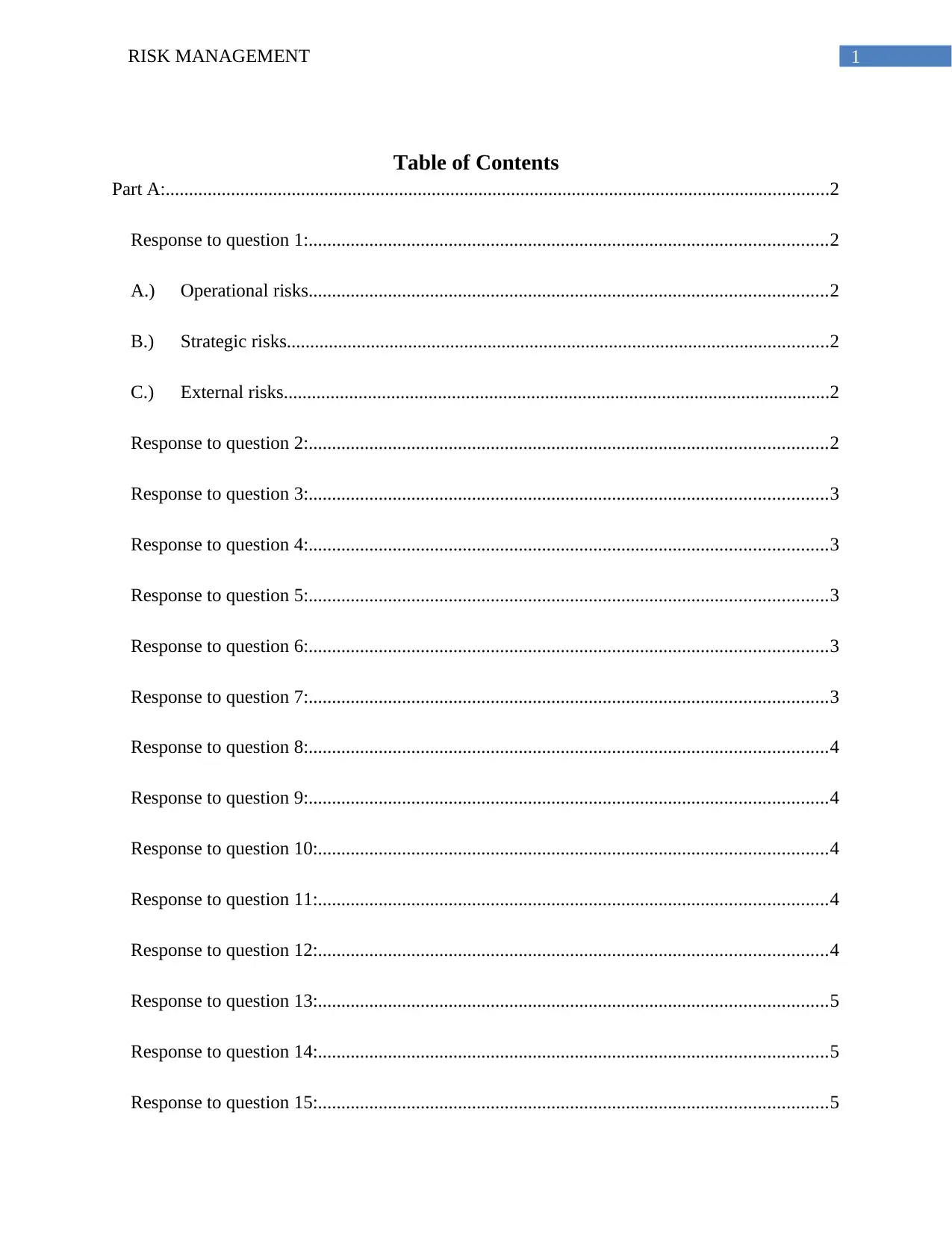
1RISK MANAGEMENT
Table of Contents
Part A:..............................................................................................................................................2
Response to question 1:...............................................................................................................2
A.) Operational risks...............................................................................................................2
B.) Strategic risks....................................................................................................................2
C.) External risks.....................................................................................................................2
Response to question 2:...............................................................................................................2
Response to question 3:...............................................................................................................3
Response to question 4:...............................................................................................................3
Response to question 5:...............................................................................................................3
Response to question 6:...............................................................................................................3
Response to question 7:...............................................................................................................3
Response to question 8:...............................................................................................................4
Response to question 9:...............................................................................................................4
Response to question 10:.............................................................................................................4
Response to question 11:.............................................................................................................4
Response to question 12:.............................................................................................................4
Response to question 13:.............................................................................................................5
Response to question 14:.............................................................................................................5
Response to question 15:.............................................................................................................5
Table of Contents
Part A:..............................................................................................................................................2
Response to question 1:...............................................................................................................2
A.) Operational risks...............................................................................................................2
B.) Strategic risks....................................................................................................................2
C.) External risks.....................................................................................................................2
Response to question 2:...............................................................................................................2
Response to question 3:...............................................................................................................3
Response to question 4:...............................................................................................................3
Response to question 5:...............................................................................................................3
Response to question 6:...............................................................................................................3
Response to question 7:...............................................................................................................3
Response to question 8:...............................................................................................................4
Response to question 9:...............................................................................................................4
Response to question 10:.............................................................................................................4
Response to question 11:.............................................................................................................4
Response to question 12:.............................................................................................................4
Response to question 13:.............................................................................................................5
Response to question 14:.............................................................................................................5
Response to question 15:.............................................................................................................5
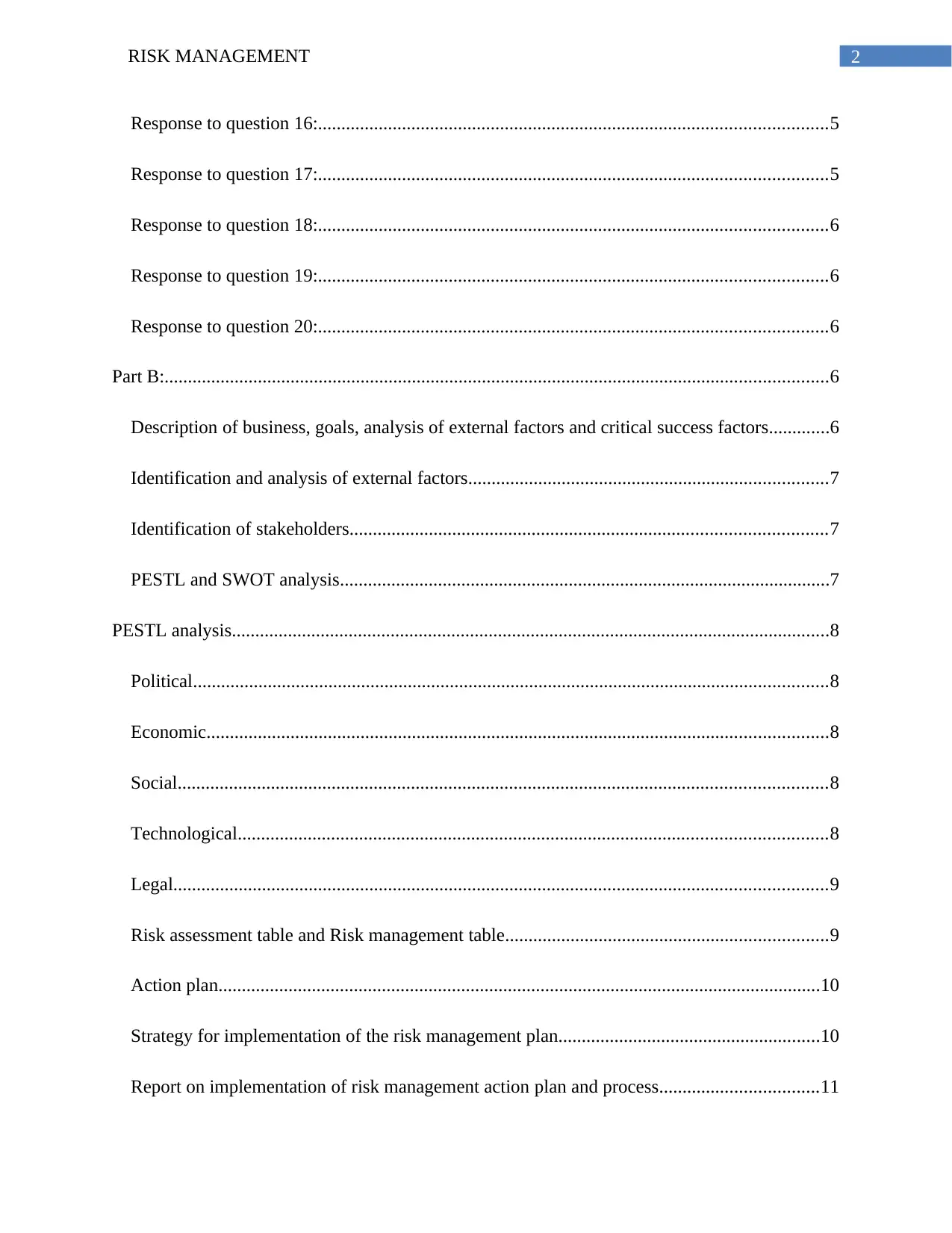
2RISK MANAGEMENT
Response to question 16:.............................................................................................................5
Response to question 17:.............................................................................................................5
Response to question 18:.............................................................................................................6
Response to question 19:.............................................................................................................6
Response to question 20:.............................................................................................................6
Part B:..............................................................................................................................................6
Description of business, goals, analysis of external factors and critical success factors.............6
Identification and analysis of external factors.............................................................................7
Identification of stakeholders......................................................................................................7
PESTL and SWOT analysis.........................................................................................................7
PESTL analysis................................................................................................................................8
Political........................................................................................................................................8
Economic.....................................................................................................................................8
Social...........................................................................................................................................8
Technological..............................................................................................................................8
Legal............................................................................................................................................9
Risk assessment table and Risk management table.....................................................................9
Action plan.................................................................................................................................10
Strategy for implementation of the risk management plan........................................................10
Report on implementation of risk management action plan and process..................................11
Response to question 16:.............................................................................................................5
Response to question 17:.............................................................................................................5
Response to question 18:.............................................................................................................6
Response to question 19:.............................................................................................................6
Response to question 20:.............................................................................................................6
Part B:..............................................................................................................................................6
Description of business, goals, analysis of external factors and critical success factors.............6
Identification and analysis of external factors.............................................................................7
Identification of stakeholders......................................................................................................7
PESTL and SWOT analysis.........................................................................................................7
PESTL analysis................................................................................................................................8
Political........................................................................................................................................8
Economic.....................................................................................................................................8
Social...........................................................................................................................................8
Technological..............................................................................................................................8
Legal............................................................................................................................................9
Risk assessment table and Risk management table.....................................................................9
Action plan.................................................................................................................................10
Strategy for implementation of the risk management plan........................................................10
Report on implementation of risk management action plan and process..................................11
⊘ This is a preview!⊘
Do you want full access?
Subscribe today to unlock all pages.

Trusted by 1+ million students worldwide
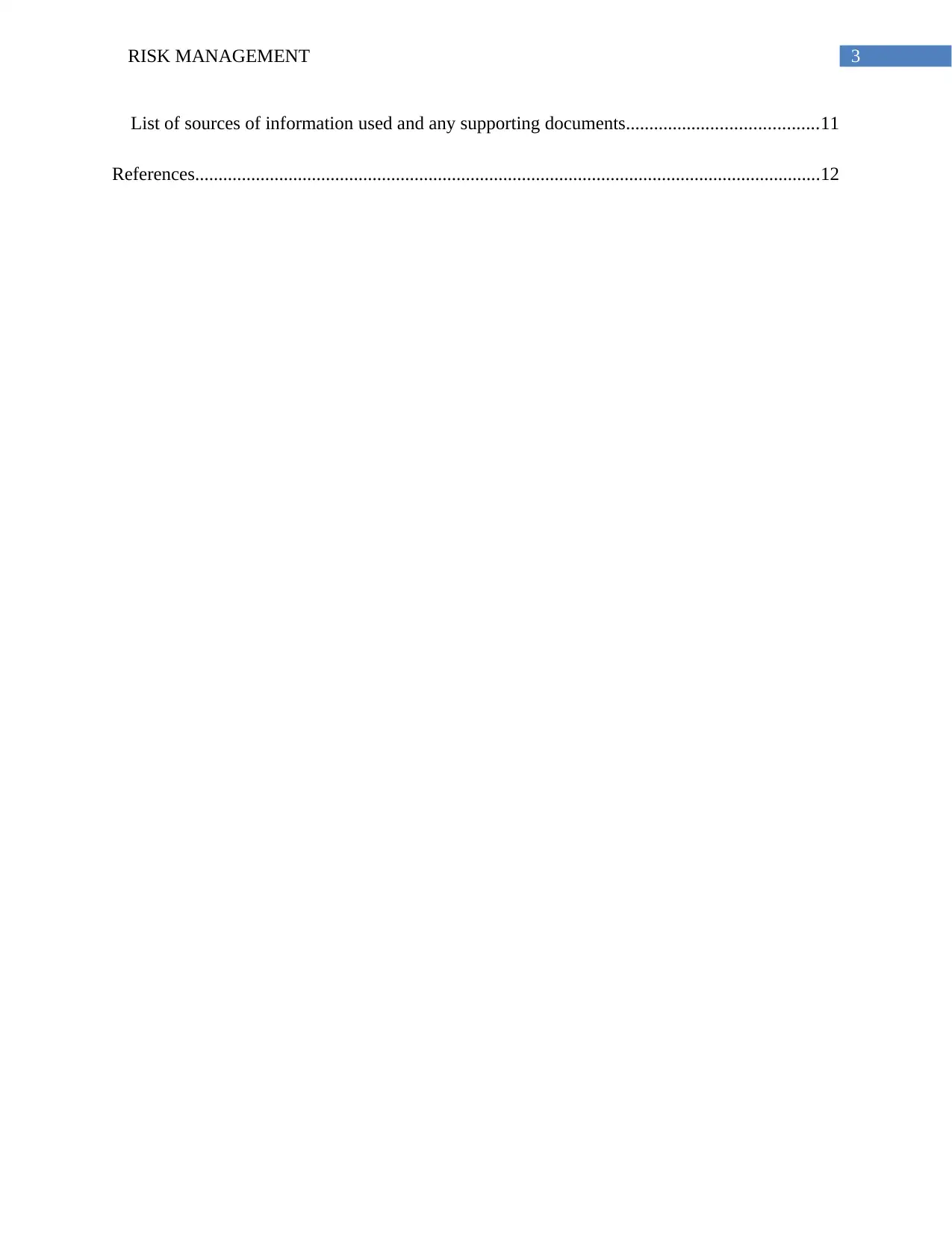
3RISK MANAGEMENT
List of sources of information used and any supporting documents.........................................11
References......................................................................................................................................12
List of sources of information used and any supporting documents.........................................11
References......................................................................................................................................12
Paraphrase This Document
Need a fresh take? Get an instant paraphrase of this document with our AI Paraphraser
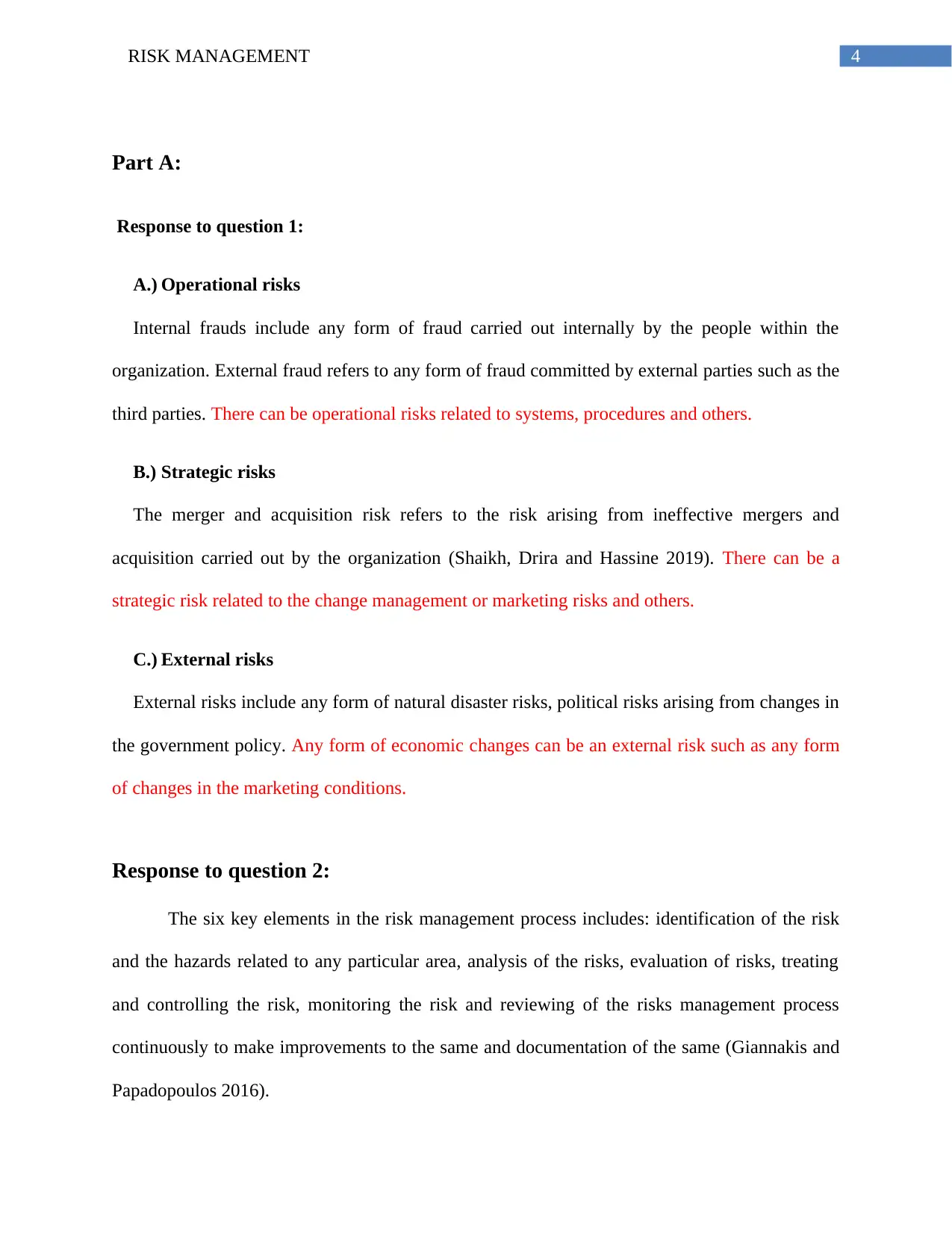
4RISK MANAGEMENT
Part A:
Response to question 1:
A.) Operational risks
Internal frauds include any form of fraud carried out internally by the people within the
organization. External fraud refers to any form of fraud committed by external parties such as the
third parties. There can be operational risks related to systems, procedures and others.
B.) Strategic risks
The merger and acquisition risk refers to the risk arising from ineffective mergers and
acquisition carried out by the organization (Shaikh, Drira and Hassine 2019). There can be a
strategic risk related to the change management or marketing risks and others.
C.) External risks
External risks include any form of natural disaster risks, political risks arising from changes in
the government policy. Any form of economic changes can be an external risk such as any form
of changes in the marketing conditions.
Response to question 2:
The six key elements in the risk management process includes: identification of the risk
and the hazards related to any particular area, analysis of the risks, evaluation of risks, treating
and controlling the risk, monitoring the risk and reviewing of the risks management process
continuously to make improvements to the same and documentation of the same (Giannakis and
Papadopoulos 2016).
Part A:
Response to question 1:
A.) Operational risks
Internal frauds include any form of fraud carried out internally by the people within the
organization. External fraud refers to any form of fraud committed by external parties such as the
third parties. There can be operational risks related to systems, procedures and others.
B.) Strategic risks
The merger and acquisition risk refers to the risk arising from ineffective mergers and
acquisition carried out by the organization (Shaikh, Drira and Hassine 2019). There can be a
strategic risk related to the change management or marketing risks and others.
C.) External risks
External risks include any form of natural disaster risks, political risks arising from changes in
the government policy. Any form of economic changes can be an external risk such as any form
of changes in the marketing conditions.
Response to question 2:
The six key elements in the risk management process includes: identification of the risk
and the hazards related to any particular area, analysis of the risks, evaluation of risks, treating
and controlling the risk, monitoring the risk and reviewing of the risks management process
continuously to make improvements to the same and documentation of the same (Giannakis and
Papadopoulos 2016).
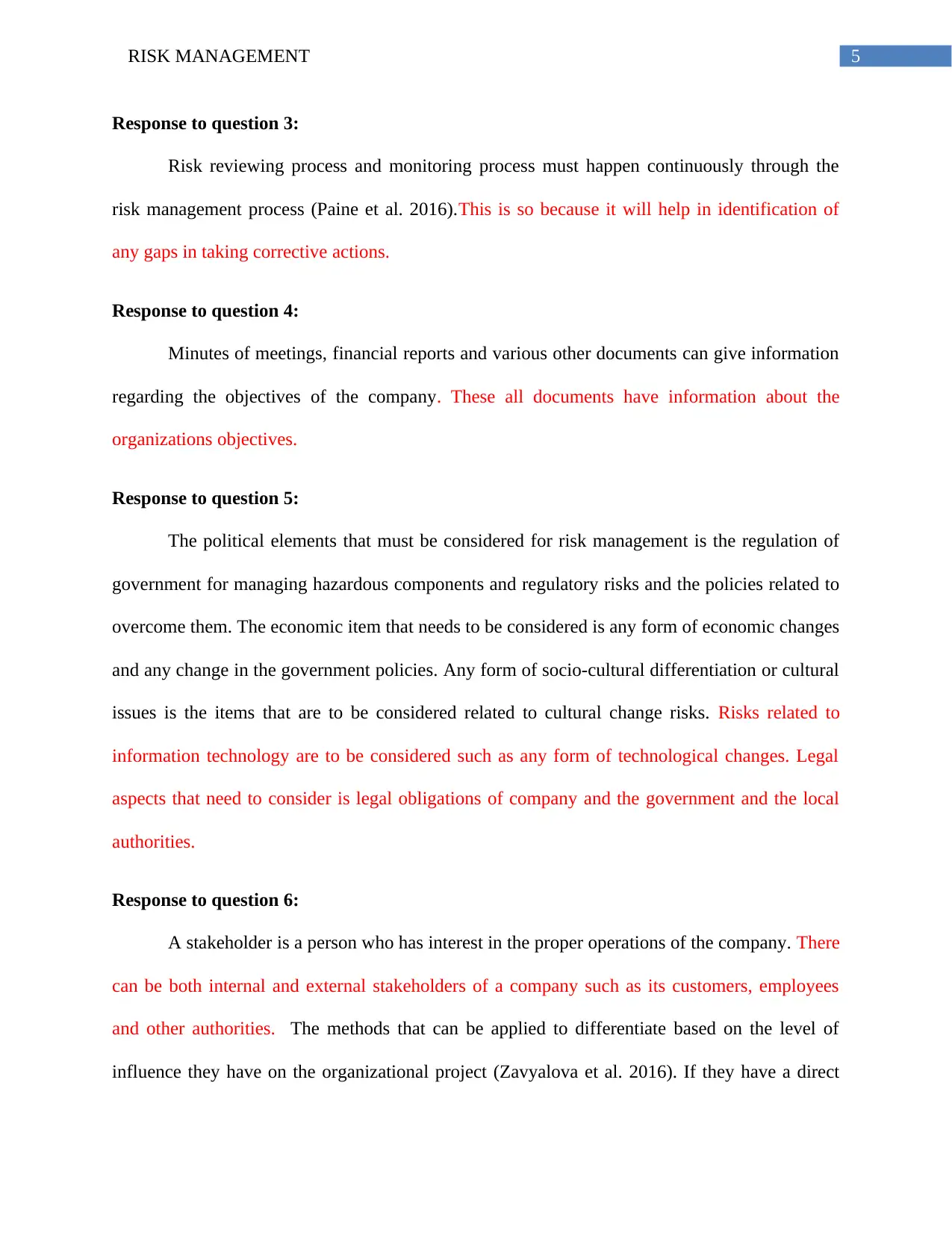
5RISK MANAGEMENT
Response to question 3:
Risk reviewing process and monitoring process must happen continuously through the
risk management process (Paine et al. 2016).This is so because it will help in identification of
any gaps in taking corrective actions.
Response to question 4:
Minutes of meetings, financial reports and various other documents can give information
regarding the objectives of the company. These all documents have information about the
organizations objectives.
Response to question 5:
The political elements that must be considered for risk management is the regulation of
government for managing hazardous components and regulatory risks and the policies related to
overcome them. The economic item that needs to be considered is any form of economic changes
and any change in the government policies. Any form of socio-cultural differentiation or cultural
issues is the items that are to be considered related to cultural change risks. Risks related to
information technology are to be considered such as any form of technological changes. Legal
aspects that need to consider is legal obligations of company and the government and the local
authorities.
Response to question 6:
A stakeholder is a person who has interest in the proper operations of the company. There
can be both internal and external stakeholders of a company such as its customers, employees
and other authorities. The methods that can be applied to differentiate based on the level of
influence they have on the organizational project (Zavyalova et al. 2016). If they have a direct
Response to question 3:
Risk reviewing process and monitoring process must happen continuously through the
risk management process (Paine et al. 2016).This is so because it will help in identification of
any gaps in taking corrective actions.
Response to question 4:
Minutes of meetings, financial reports and various other documents can give information
regarding the objectives of the company. These all documents have information about the
organizations objectives.
Response to question 5:
The political elements that must be considered for risk management is the regulation of
government for managing hazardous components and regulatory risks and the policies related to
overcome them. The economic item that needs to be considered is any form of economic changes
and any change in the government policies. Any form of socio-cultural differentiation or cultural
issues is the items that are to be considered related to cultural change risks. Risks related to
information technology are to be considered such as any form of technological changes. Legal
aspects that need to consider is legal obligations of company and the government and the local
authorities.
Response to question 6:
A stakeholder is a person who has interest in the proper operations of the company. There
can be both internal and external stakeholders of a company such as its customers, employees
and other authorities. The methods that can be applied to differentiate based on the level of
influence they have on the organizational project (Zavyalova et al. 2016). If they have a direct
⊘ This is a preview!⊘
Do you want full access?
Subscribe today to unlock all pages.

Trusted by 1+ million students worldwide
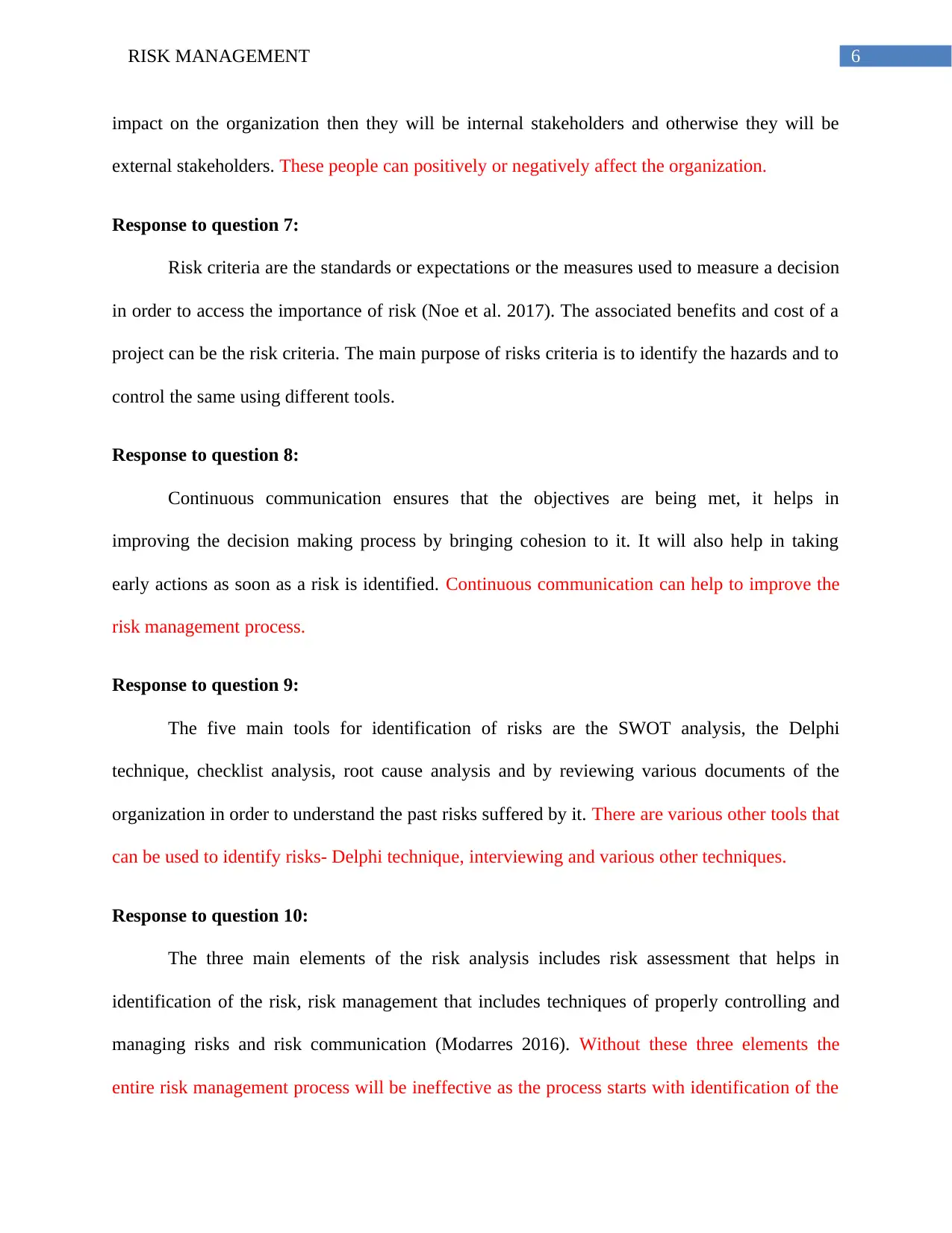
6RISK MANAGEMENT
impact on the organization then they will be internal stakeholders and otherwise they will be
external stakeholders. These people can positively or negatively affect the organization.
Response to question 7:
Risk criteria are the standards or expectations or the measures used to measure a decision
in order to access the importance of risk (Noe et al. 2017). The associated benefits and cost of a
project can be the risk criteria. The main purpose of risks criteria is to identify the hazards and to
control the same using different tools.
Response to question 8:
Continuous communication ensures that the objectives are being met, it helps in
improving the decision making process by bringing cohesion to it. It will also help in taking
early actions as soon as a risk is identified. Continuous communication can help to improve the
risk management process.
Response to question 9:
The five main tools for identification of risks are the SWOT analysis, the Delphi
technique, checklist analysis, root cause analysis and by reviewing various documents of the
organization in order to understand the past risks suffered by it. There are various other tools that
can be used to identify risks- Delphi technique, interviewing and various other techniques.
Response to question 10:
The three main elements of the risk analysis includes risk assessment that helps in
identification of the risk, risk management that includes techniques of properly controlling and
managing risks and risk communication (Modarres 2016). Without these three elements the
entire risk management process will be ineffective as the process starts with identification of the
impact on the organization then they will be internal stakeholders and otherwise they will be
external stakeholders. These people can positively or negatively affect the organization.
Response to question 7:
Risk criteria are the standards or expectations or the measures used to measure a decision
in order to access the importance of risk (Noe et al. 2017). The associated benefits and cost of a
project can be the risk criteria. The main purpose of risks criteria is to identify the hazards and to
control the same using different tools.
Response to question 8:
Continuous communication ensures that the objectives are being met, it helps in
improving the decision making process by bringing cohesion to it. It will also help in taking
early actions as soon as a risk is identified. Continuous communication can help to improve the
risk management process.
Response to question 9:
The five main tools for identification of risks are the SWOT analysis, the Delphi
technique, checklist analysis, root cause analysis and by reviewing various documents of the
organization in order to understand the past risks suffered by it. There are various other tools that
can be used to identify risks- Delphi technique, interviewing and various other techniques.
Response to question 10:
The three main elements of the risk analysis includes risk assessment that helps in
identification of the risk, risk management that includes techniques of properly controlling and
managing risks and risk communication (Modarres 2016). Without these three elements the
entire risk management process will be ineffective as the process starts with identification of the
Paraphrase This Document
Need a fresh take? Get an instant paraphrase of this document with our AI Paraphraser
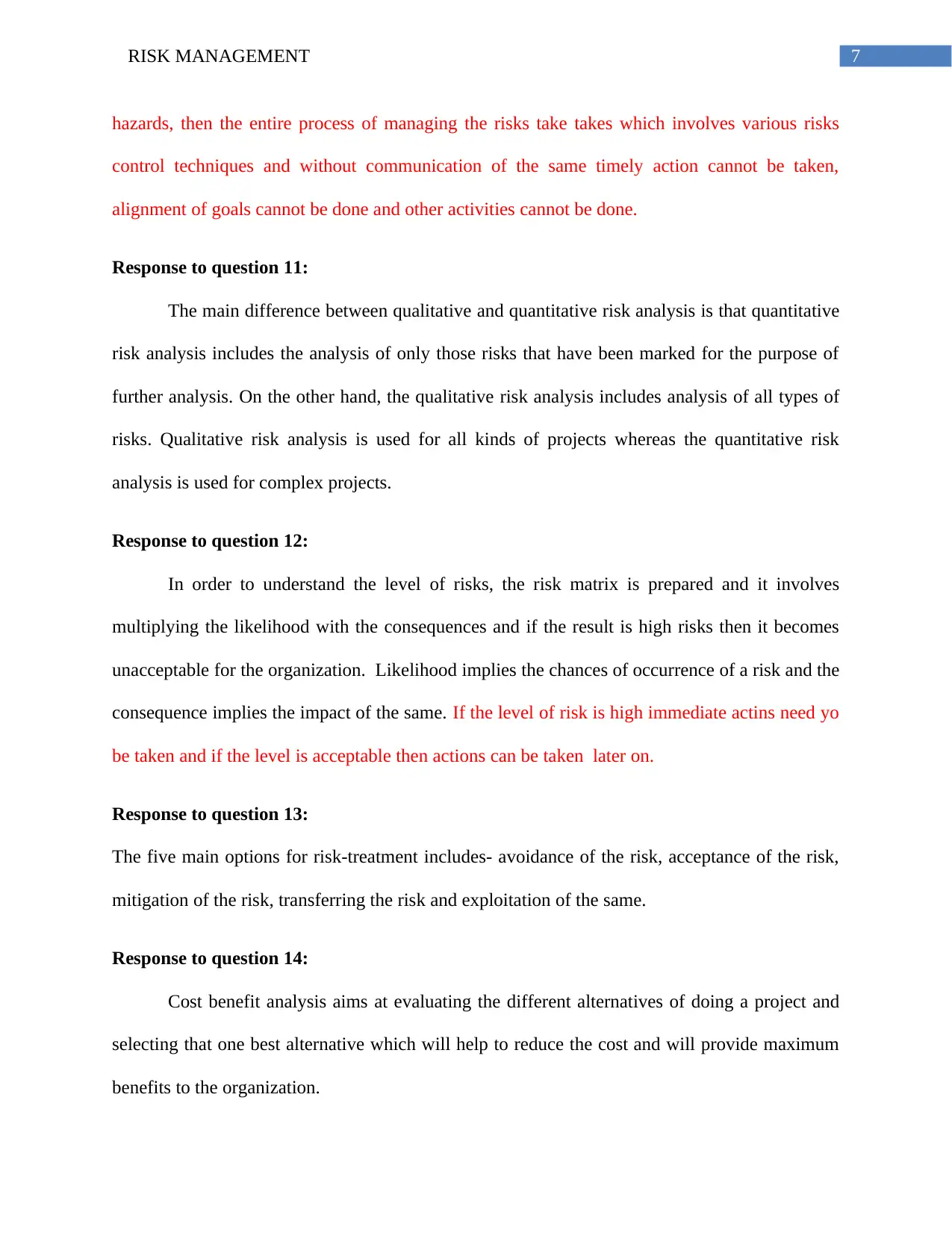
7RISK MANAGEMENT
hazards, then the entire process of managing the risks take takes which involves various risks
control techniques and without communication of the same timely action cannot be taken,
alignment of goals cannot be done and other activities cannot be done.
Response to question 11:
The main difference between qualitative and quantitative risk analysis is that quantitative
risk analysis includes the analysis of only those risks that have been marked for the purpose of
further analysis. On the other hand, the qualitative risk analysis includes analysis of all types of
risks. Qualitative risk analysis is used for all kinds of projects whereas the quantitative risk
analysis is used for complex projects.
Response to question 12:
In order to understand the level of risks, the risk matrix is prepared and it involves
multiplying the likelihood with the consequences and if the result is high risks then it becomes
unacceptable for the organization. Likelihood implies the chances of occurrence of a risk and the
consequence implies the impact of the same. If the level of risk is high immediate actins need yo
be taken and if the level is acceptable then actions can be taken later on.
Response to question 13:
The five main options for risk-treatment includes- avoidance of the risk, acceptance of the risk,
mitigation of the risk, transferring the risk and exploitation of the same.
Response to question 14:
Cost benefit analysis aims at evaluating the different alternatives of doing a project and
selecting that one best alternative which will help to reduce the cost and will provide maximum
benefits to the organization.
hazards, then the entire process of managing the risks take takes which involves various risks
control techniques and without communication of the same timely action cannot be taken,
alignment of goals cannot be done and other activities cannot be done.
Response to question 11:
The main difference between qualitative and quantitative risk analysis is that quantitative
risk analysis includes the analysis of only those risks that have been marked for the purpose of
further analysis. On the other hand, the qualitative risk analysis includes analysis of all types of
risks. Qualitative risk analysis is used for all kinds of projects whereas the quantitative risk
analysis is used for complex projects.
Response to question 12:
In order to understand the level of risks, the risk matrix is prepared and it involves
multiplying the likelihood with the consequences and if the result is high risks then it becomes
unacceptable for the organization. Likelihood implies the chances of occurrence of a risk and the
consequence implies the impact of the same. If the level of risk is high immediate actins need yo
be taken and if the level is acceptable then actions can be taken later on.
Response to question 13:
The five main options for risk-treatment includes- avoidance of the risk, acceptance of the risk,
mitigation of the risk, transferring the risk and exploitation of the same.
Response to question 14:
Cost benefit analysis aims at evaluating the different alternatives of doing a project and
selecting that one best alternative which will help to reduce the cost and will provide maximum
benefits to the organization.
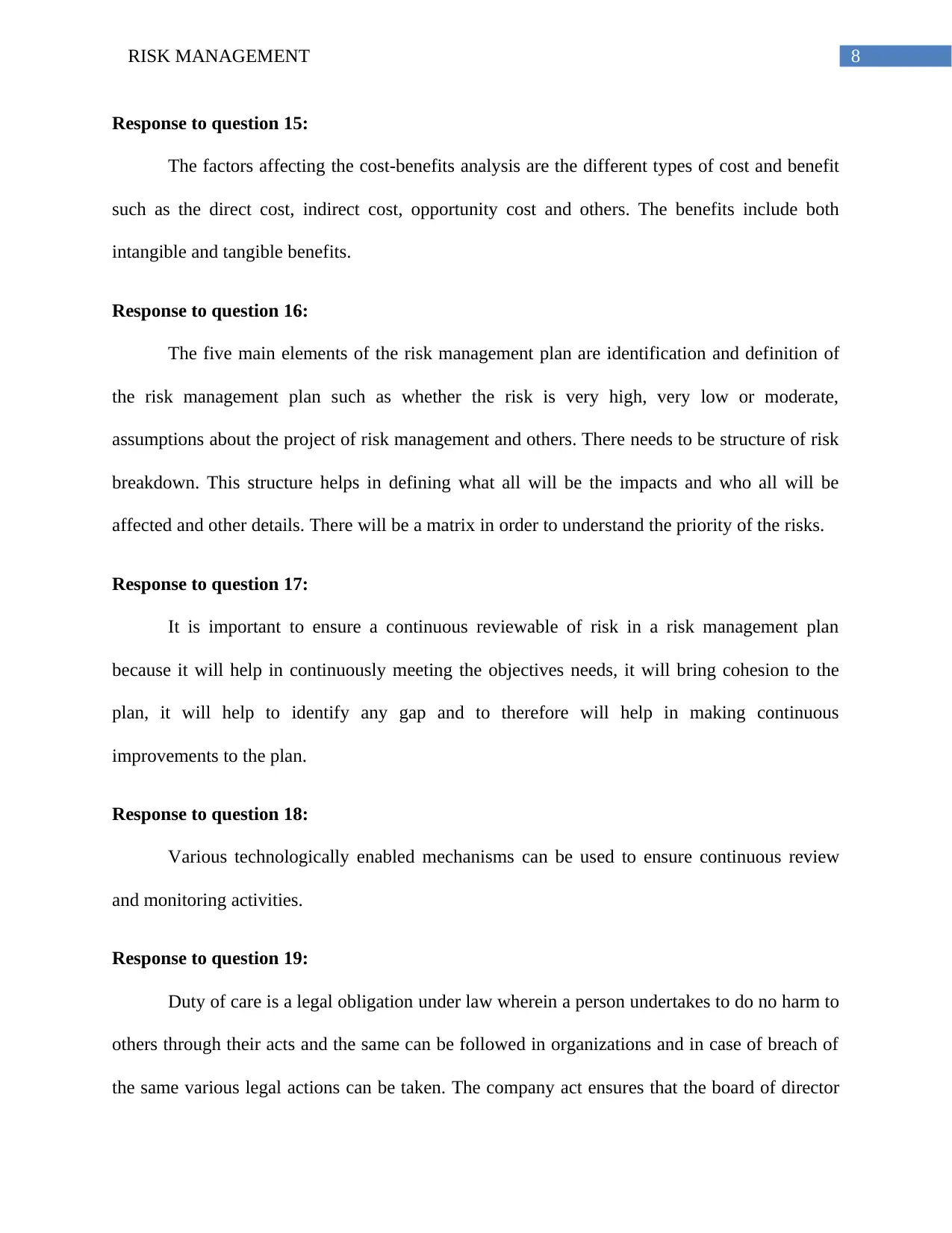
8RISK MANAGEMENT
Response to question 15:
The factors affecting the cost-benefits analysis are the different types of cost and benefit
such as the direct cost, indirect cost, opportunity cost and others. The benefits include both
intangible and tangible benefits.
Response to question 16:
The five main elements of the risk management plan are identification and definition of
the risk management plan such as whether the risk is very high, very low or moderate,
assumptions about the project of risk management and others. There needs to be structure of risk
breakdown. This structure helps in defining what all will be the impacts and who all will be
affected and other details. There will be a matrix in order to understand the priority of the risks.
Response to question 17:
It is important to ensure a continuous reviewable of risk in a risk management plan
because it will help in continuously meeting the objectives needs, it will bring cohesion to the
plan, it will help to identify any gap and to therefore will help in making continuous
improvements to the plan.
Response to question 18:
Various technologically enabled mechanisms can be used to ensure continuous review
and monitoring activities.
Response to question 19:
Duty of care is a legal obligation under law wherein a person undertakes to do no harm to
others through their acts and the same can be followed in organizations and in case of breach of
the same various legal actions can be taken. The company act ensures that the board of director
Response to question 15:
The factors affecting the cost-benefits analysis are the different types of cost and benefit
such as the direct cost, indirect cost, opportunity cost and others. The benefits include both
intangible and tangible benefits.
Response to question 16:
The five main elements of the risk management plan are identification and definition of
the risk management plan such as whether the risk is very high, very low or moderate,
assumptions about the project of risk management and others. There needs to be structure of risk
breakdown. This structure helps in defining what all will be the impacts and who all will be
affected and other details. There will be a matrix in order to understand the priority of the risks.
Response to question 17:
It is important to ensure a continuous reviewable of risk in a risk management plan
because it will help in continuously meeting the objectives needs, it will bring cohesion to the
plan, it will help to identify any gap and to therefore will help in making continuous
improvements to the plan.
Response to question 18:
Various technologically enabled mechanisms can be used to ensure continuous review
and monitoring activities.
Response to question 19:
Duty of care is a legal obligation under law wherein a person undertakes to do no harm to
others through their acts and the same can be followed in organizations and in case of breach of
the same various legal actions can be taken. The company act ensures that the board of director
⊘ This is a preview!⊘
Do you want full access?
Subscribe today to unlock all pages.

Trusted by 1+ million students worldwide
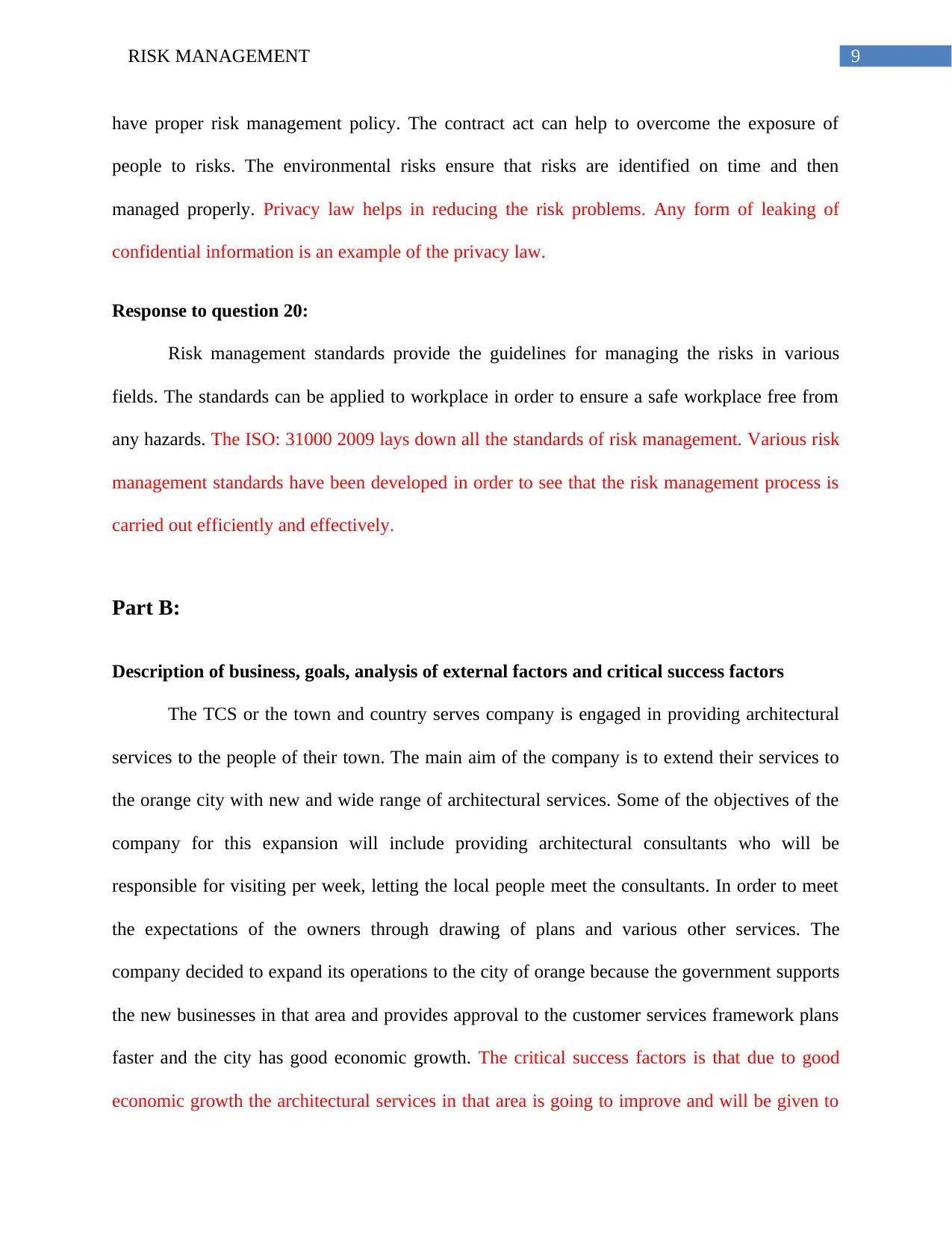
9RISK MANAGEMENT
have proper risk management policy. The contract act can help to overcome the exposure of
people to risks. The environmental risks ensure that risks are identified on time and then
managed properly. Privacy law helps in reducing the risk problems. Any form of leaking of
confidential information is an example of the privacy law.
Response to question 20:
Risk management standards provide the guidelines for managing the risks in various
fields. The standards can be applied to workplace in order to ensure a safe workplace free from
any hazards. The ISO: 31000 2009 lays down all the standards of risk management. Various risk
management standards have been developed in order to see that the risk management process is
carried out efficiently and effectively.
Part B:
Description of business, goals, analysis of external factors and critical success factors
The TCS or the town and country serves company is engaged in providing architectural
services to the people of their town. The main aim of the company is to extend their services to
the orange city with new and wide range of architectural services. Some of the objectives of the
company for this expansion will include providing architectural consultants who will be
responsible for visiting per week, letting the local people meet the consultants. In order to meet
the expectations of the owners through drawing of plans and various other services. The
company decided to expand its operations to the city of orange because the government supports
the new businesses in that area and provides approval to the customer services framework plans
faster and the city has good economic growth. The critical success factors is that due to good
economic growth the architectural services in that area is going to improve and will be given to
have proper risk management policy. The contract act can help to overcome the exposure of
people to risks. The environmental risks ensure that risks are identified on time and then
managed properly. Privacy law helps in reducing the risk problems. Any form of leaking of
confidential information is an example of the privacy law.
Response to question 20:
Risk management standards provide the guidelines for managing the risks in various
fields. The standards can be applied to workplace in order to ensure a safe workplace free from
any hazards. The ISO: 31000 2009 lays down all the standards of risk management. Various risk
management standards have been developed in order to see that the risk management process is
carried out efficiently and effectively.
Part B:
Description of business, goals, analysis of external factors and critical success factors
The TCS or the town and country serves company is engaged in providing architectural
services to the people of their town. The main aim of the company is to extend their services to
the orange city with new and wide range of architectural services. Some of the objectives of the
company for this expansion will include providing architectural consultants who will be
responsible for visiting per week, letting the local people meet the consultants. In order to meet
the expectations of the owners through drawing of plans and various other services. The
company decided to expand its operations to the city of orange because the government supports
the new businesses in that area and provides approval to the customer services framework plans
faster and the city has good economic growth. The critical success factors is that due to good
economic growth the architectural services in that area is going to improve and will be given to
Paraphrase This Document
Need a fresh take? Get an instant paraphrase of this document with our AI Paraphraser
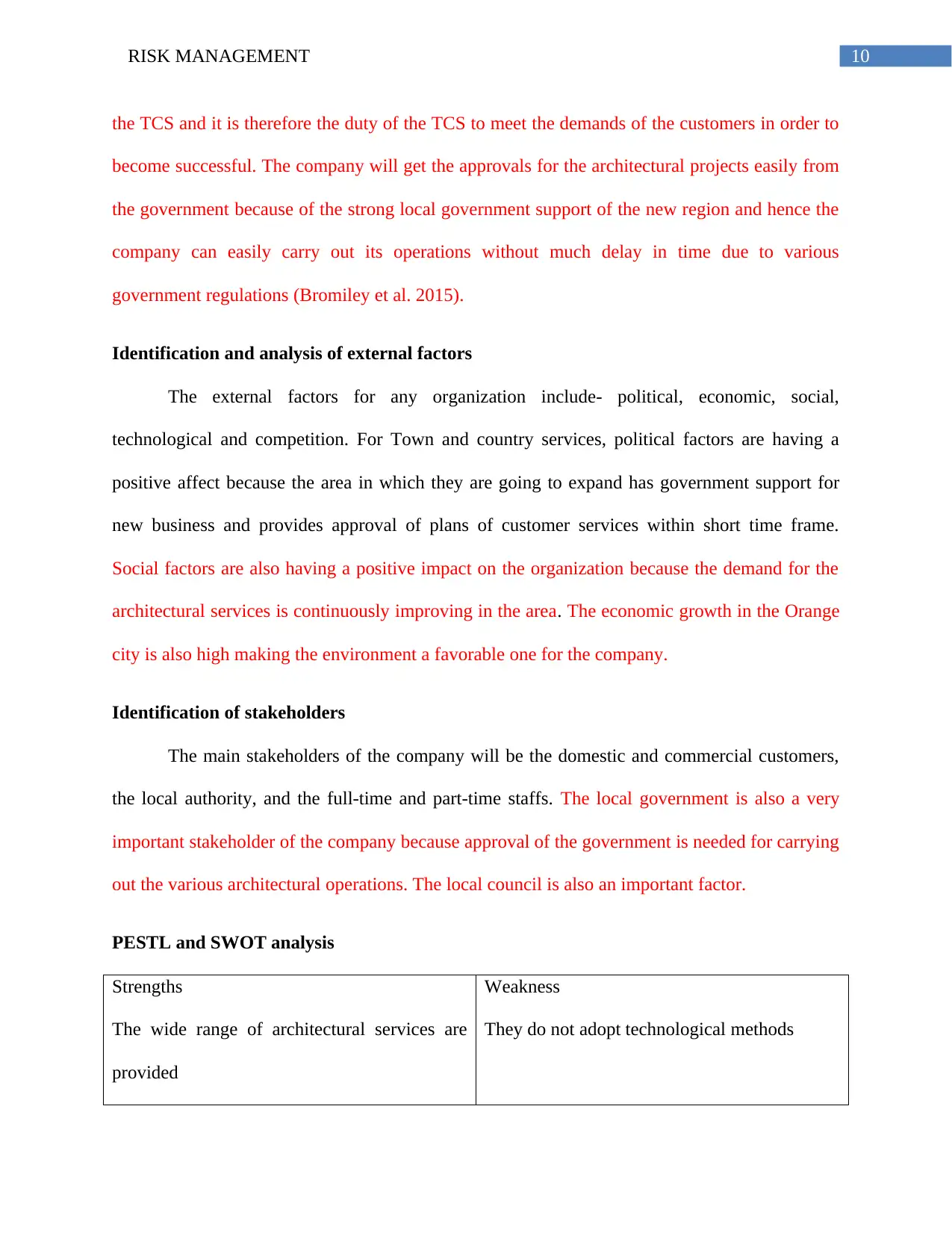
10RISK MANAGEMENT
the TCS and it is therefore the duty of the TCS to meet the demands of the customers in order to
become successful. The company will get the approvals for the architectural projects easily from
the government because of the strong local government support of the new region and hence the
company can easily carry out its operations without much delay in time due to various
government regulations (Bromiley et al. 2015).
Identification and analysis of external factors
The external factors for any organization include- political, economic, social,
technological and competition. For Town and country services, political factors are having a
positive affect because the area in which they are going to expand has government support for
new business and provides approval of plans of customer services within short time frame.
Social factors are also having a positive impact on the organization because the demand for the
architectural services is continuously improving in the area. The economic growth in the Orange
city is also high making the environment a favorable one for the company.
Identification of stakeholders
The main stakeholders of the company will be the domestic and commercial customers,
the local authority, and the full-time and part-time staffs. The local government is also a very
important stakeholder of the company because approval of the government is needed for carrying
out the various architectural operations. The local council is also an important factor.
PESTL and SWOT analysis
Strengths
The wide range of architectural services are
provided
Weakness
They do not adopt technological methods
the TCS and it is therefore the duty of the TCS to meet the demands of the customers in order to
become successful. The company will get the approvals for the architectural projects easily from
the government because of the strong local government support of the new region and hence the
company can easily carry out its operations without much delay in time due to various
government regulations (Bromiley et al. 2015).
Identification and analysis of external factors
The external factors for any organization include- political, economic, social,
technological and competition. For Town and country services, political factors are having a
positive affect because the area in which they are going to expand has government support for
new business and provides approval of plans of customer services within short time frame.
Social factors are also having a positive impact on the organization because the demand for the
architectural services is continuously improving in the area. The economic growth in the Orange
city is also high making the environment a favorable one for the company.
Identification of stakeholders
The main stakeholders of the company will be the domestic and commercial customers,
the local authority, and the full-time and part-time staffs. The local government is also a very
important stakeholder of the company because approval of the government is needed for carrying
out the various architectural operations. The local council is also an important factor.
PESTL and SWOT analysis
Strengths
The wide range of architectural services are
provided
Weakness
They do not adopt technological methods
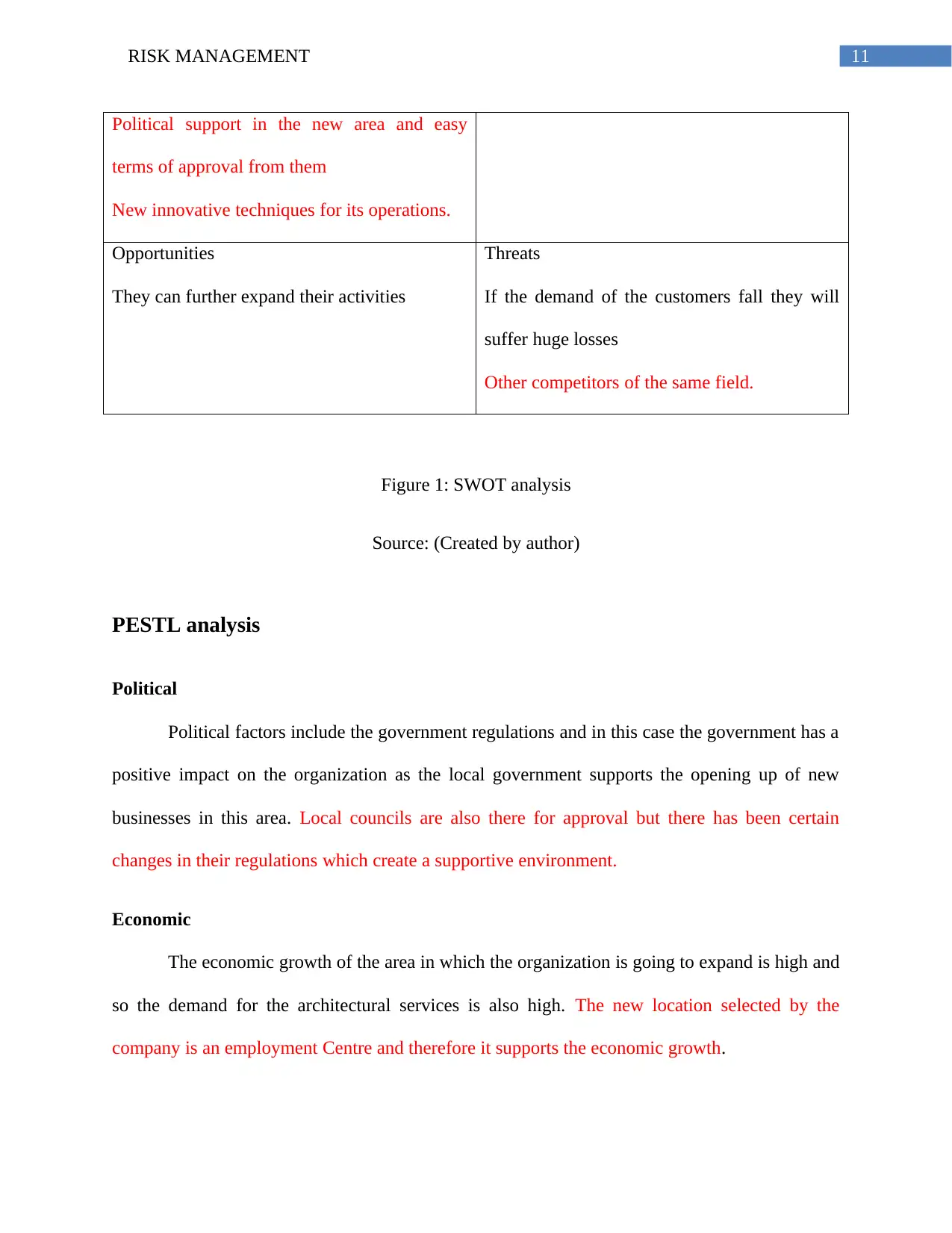
11RISK MANAGEMENT
Political support in the new area and easy
terms of approval from them
New innovative techniques for its operations.
Opportunities
They can further expand their activities
Threats
If the demand of the customers fall they will
suffer huge losses
Other competitors of the same field.
Figure 1: SWOT analysis
Source: (Created by author)
PESTL analysis
Political
Political factors include the government regulations and in this case the government has a
positive impact on the organization as the local government supports the opening up of new
businesses in this area. Local councils are also there for approval but there has been certain
changes in their regulations which create a supportive environment.
Economic
The economic growth of the area in which the organization is going to expand is high and
so the demand for the architectural services is also high. The new location selected by the
company is an employment Centre and therefore it supports the economic growth.
Political support in the new area and easy
terms of approval from them
New innovative techniques for its operations.
Opportunities
They can further expand their activities
Threats
If the demand of the customers fall they will
suffer huge losses
Other competitors of the same field.
Figure 1: SWOT analysis
Source: (Created by author)
PESTL analysis
Political
Political factors include the government regulations and in this case the government has a
positive impact on the organization as the local government supports the opening up of new
businesses in this area. Local councils are also there for approval but there has been certain
changes in their regulations which create a supportive environment.
Economic
The economic growth of the area in which the organization is going to expand is high and
so the demand for the architectural services is also high. The new location selected by the
company is an employment Centre and therefore it supports the economic growth.
⊘ This is a preview!⊘
Do you want full access?
Subscribe today to unlock all pages.

Trusted by 1+ million students worldwide
1 out of 18
Related Documents
Your All-in-One AI-Powered Toolkit for Academic Success.
+13062052269
info@desklib.com
Available 24*7 on WhatsApp / Email
![[object Object]](/_next/static/media/star-bottom.7253800d.svg)
Unlock your academic potential
Copyright © 2020–2025 A2Z Services. All Rights Reserved. Developed and managed by ZUCOL.





